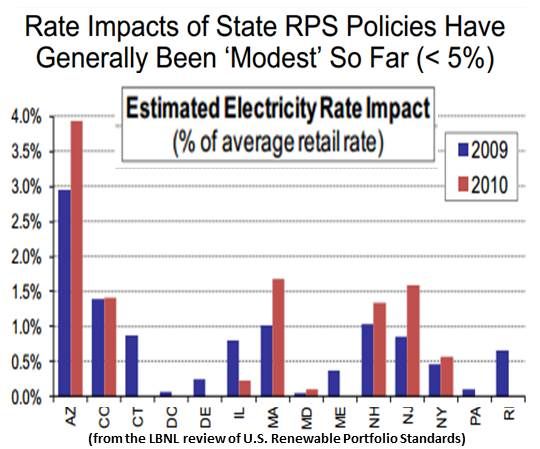A new review of the impact of U.S. Renewable Portfolio Standards (RPSs) concluded that, contrary to claims by some conservatives and fossil fuel industry advocates, the RPS is an effective way to grow renewables capacity and does not inordinately affect consumers’ utility bills.
The report, Renewables Portfolio Standards in the United States: An Update, by Lawrence Berkeley National Laboratory’s Galen Barbose, found that the 29 states and the District of Columbia that have “a requirement on retail electric suppliers to supply a minimum percentage or amount of their retail load with eligible sources of renewable energy” account for 54 percent of U.S. retail electricity sales.
A total of 33 gigawatts of the 52 gigawatts of non-hydro renewables built in the U.S. from 1998 to 2011 were, the review reported, likely driven by RPSs. Over the course of that entire period, 89 percent of that capacity has been wind and 6 percent has been solar, but solar won an increasing proportion in 2010 and 2011.

The seventeen states with solar or distributed generation carve-outs are expected to have a cumulative installed solar/distributed generation capacity of 8,500 megawatts by 2025.
Rate impacts vary by state and RPS design, but there has been a less than 5 percent average rate increase across the board, and some states may have seen rate decreases.
Full compliance with existing RPSs and voluntary goals will result in 102 gigawatts more of new non-hydro renewable capacity by 2035.
RPSs are typically backed with non-compliance penalties and often include a tradable renewable energy credit (REC) program to drive participation.

No state has enacted an RPS since 2009, but twelve states (CA, IL, CT, MA, DC, MD, NJ, DE, NH, OH, NC, WI) have edited their RPSs in the last two years. The general trends include an expanded resource eligibility list, more stringent purchase targets, resource-specific carve-outs, more precise solar carve-out provisions, and the refining of REC markets.
Ten political efforts to repeal RPSs failed in 2011 and 2012, but efforts to expand the definition of renewables and challenge the legality of the standards continue.



